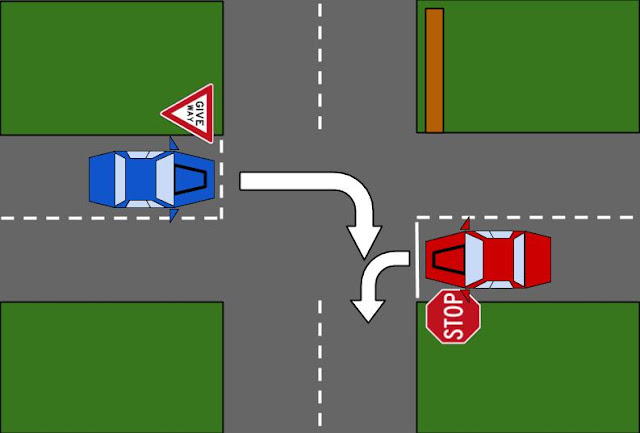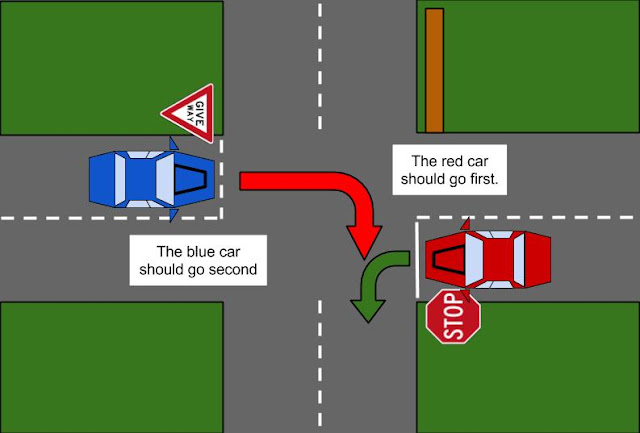Once students are comfortable with handling the car it comes time to learn the road rules. Start with learning the different type of road signs (which you can read here). Then move on to using these signs and who has right of way. I also explain the difference between give-way signs and stop signs, as well as how to use them correctly (which you can read here).
Who has right of way is very simple and important to know, yet many don't understand it correctly. So here I'll explain who has right of way in different situations in a simple and memorable way.
In the first picture below we have a red car waiting to turn left, and a blue car waiting to turn right. Who gets to go first?
Almost half of all my students (not just learners) get this wrong, and many who get it right just guess.
The answer: The red car goes first. As you can see below the red car should go first as it has the right of way over the blue car.
Many think the blue car should go first because the red one is on a stop sign, while the blue is only on a give-way sign. This is wrong, the signs are the same. A stop-sign is just a dangerous give-way sign that you need to be more cautious with.
A stop-sign and give-way sign have the same rights, they are essentially the same sign. This means both the red and blue car are completely equal at the intersection. Road rules have to be easy to understand and apply universally to any situation.
If the car at the give-way sign could go first then it would be confusing and complicated with other situations. For example, below is a situation where neither car is on a sign, so they're both equal again.
In both situations where both cars are equal the same rules apply, nice and simple, easy remember and easy to follow when driving.
So if both cars are equal the rule Straight, then Left, then Right (SLR) applies. This means, the car closest to their original path goes first. Because you drive straight to every intersection the car going straight goes first. Then left is the next closest, so the car turning left goes next. Finally, the car turning right can go.
Basically you just need to remember STRAIGHT, then LEFT, then RIGHT (SLR).
2. This rule only applies if both cars are equal, so if both have the same conditions.
3. You can both go in the same direction at the same time, so you can turn left as they turn left, or turn right as they turn right. Just make sure they're actually going that way and don't swing! People are idiots, assume everyone (including you) is an idiot driver.
- My guide to stop signs and give-way signs:
http://australiandrivertraining.blogspot.com.au/2017/04/stop-signs-and-give-way-signs.html
Who has right of way is very simple and important to know, yet many don't understand it correctly. So here I'll explain who has right of way in different situations in a simple and memorable way.
Almost half of all my students (not just learners) get this wrong, and many who get it right just guess.
 |
| Who gets to go first? |
 |
| The red car goes first, blue car last. |
 |
| The red car goes first, followed by the blue car. |
If the car at the give-way sign could go first then it would be confusing and complicated with other situations. For example, below is a situation where neither car is on a sign, so they're both equal again.
 |
| Again, both cars are equal so the rules don't change. |
 |
| An example of Straight, then Left, then Right. |
Basically you just need to remember STRAIGHT, then LEFT, then RIGHT (SLR).
 |
| Again, Straight, then Left, then Right. |
Simple Tips To Remember:
1. It's not about how where the cars are going, it's about where they came from. So how many lanes they need to cross or how car they need to go doesn't matter in this context.2. This rule only applies if both cars are equal, so if both have the same conditions.
3. You can both go in the same direction at the same time, so you can turn left as they turn left, or turn right as they turn right. Just make sure they're actually going that way and don't swing! People are idiots, assume everyone (including you) is an idiot driver.
- My guide to stop signs and give-way signs:
http://australiandrivertraining.blogspot.com.au/2017/04/stop-signs-and-give-way-signs.html
